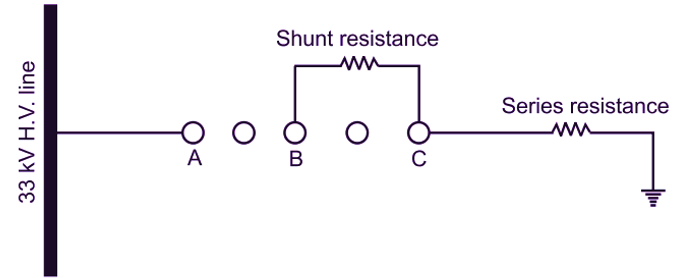Multi gap Arrester is used for power lines voltage not exceeding 33 kV.

Fig. 1 : Multi gap Arrester
Construction of Multi gap Arrester
Multi gap Arrester is superior than rod-gap and horn type arrester. There are arc (air) gaps between A, B and C. And shunt resistance is connected between B and C whereas, from the last C connection goes to earth via series resistance. The cylinders A, B, C etc. are made of zinc alloys and are separated by gaps and insulated from one another. Cylinder ‘A’ is connected electrically to the H.V. line as shown 33 kV. The last ‘C’ cylinder connection goes to earth via series resistance. By introducing series resistance the degree of protection against travelling waves is reduced but this is compensated by connecting shunt resistance between B and C.
Working of Multi gap Arrester
Under normal working voltage (say 33 kV) ‘B’ is at the ground potential, hence series gaps are open and no arcing between the gaps is possible. If now over voltage such as transients or surges are developed this very high voltage is sufficient to produce arc between gap A and B. This surge heavy current will follow the straight through path to earth via shunted gap B and C instead of alternative path through shunt resistance. When surge is over the arc B to C go out and at all if any current persists it is limited by these two resistances which form a series circuit. This current is too small to maintain the arc between A and B. In this way the normal conditions are restored and system functions on normal working voltage. The equipment is thus protected from over voltage.
Use of Multi gap Arrester
These are suitable for the power line equipment upto 33 kV.